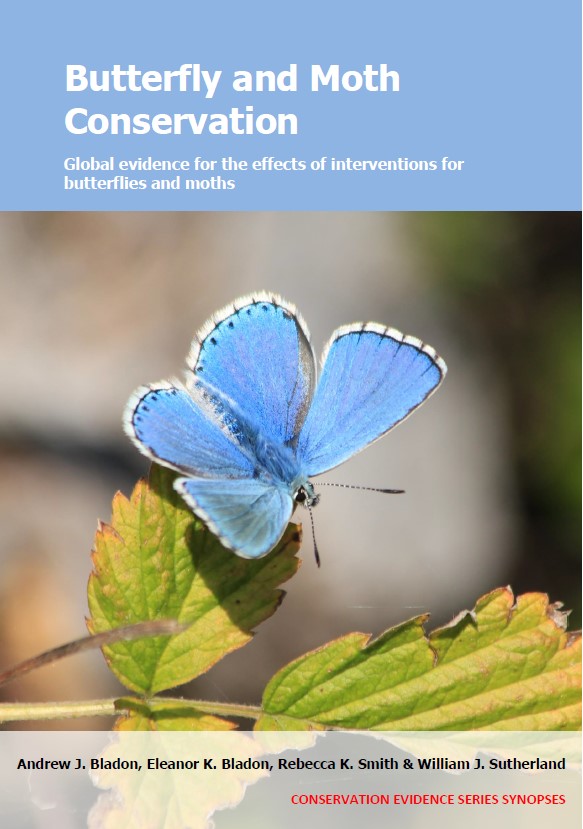Actions to conserve biodiversity
We have summarised evidence from the scientific literature about the effects of actions to conserve wildlife and ecosystems.
Review the evidence from the studies
Not sure what Actions are? Read a brief description.
Search for evidence
e.g. "frogs chytrid"
152 Actions found
Refine
Hide
152 Actions found
Download Actions
| 0 selected |
|
Order results by:
| Action | Effectiveness | Studies | Category | |
|---|---|---|---|---|
|
Increase biosecurity checks Action Link |
No evidence found (no assessment) | 0 |
|
|
|
Increase consideration of butterflies and moths in international, national and local conservation plans Action Link |
No evidence found (no assessment) | 0 |
|
|
|
Increase crop diversity across a farm or farmed landscape Action Link |
Awaiting assessment | 2 |
|
|
|
Increase grazing intensity or cutting frequency on grassland Action Link |
Evidence not assessed | 5 |
|
|
|
Increase or maintain the proportion of natural or semi‐natural habitat in the farmed landscape Action Link |
Evidence not assessed | 12 |
|
|
|
Install artificial dams in streams to raise water levels Action Link |
Awaiting assessment | 1 |
|
|
|
Introduce legislation to control the use of hazardous substances Action Link |
No evidence found (no assessment) | 0 |
|
|
|
Introduce mated females to increase genetic diversity Action Link |
No evidence found (no assessment) | 0 |
|
|
|
Leave headlands in fields unsprayed (conservation headlands) Action Link |
Awaiting assessment | 6 |
|
|
|
Leave some areas unburned during prescribed burning Action Link |
Awaiting assessment | 2 |
|
|
|
Leave uncropped, cultivated margins or plots Action Link |
Evidence not assessed | 4 |
|
|
|
Leave unharvested crop headlands within arable fields Action Link |
Awaiting assessment | 1 |
|
|
|
Legally protect butterflies and moths Action Link |
No evidence found (no assessment) | 0 |
|
|
|
Legally protect habitat Action Link |
Evidence not assessed | 10 |
|
|
|
Legally protect large native trees Action Link |
No evidence found (no assessment) | 0 |
|
|
|
Maintain or create bare ground Action Link |
Evidence not assessed | 4 |
|
|
|
Maintain or restore native wood pasture and parkland Action Link |
No evidence found (no assessment) | 0 |
|
|
|
Maintain or restore traditional water meadows and bogs Action Link |
Awaiting assessment | 5 |
|
|
|
Maintain species-rich, semi-natural grassland Action Link |
Awaiting assessment | 19 |
|
|
|
Maintain traditional orchards to benefit butterflies and moths Action Link |
Awaiting assessment | 2 |
|
|
|
Maintain upland heath/moorland Action Link |
Awaiting assessment | 3 |
|
|
|
Manage ditches to benefit butterflies and moths Action Link |
No evidence found (no assessment) | 0 |
|
|
|
Manage heathland by cutting Action Link |
Evidence not assessed | 3 |
|
|
|
Manage hedgerows to benefit wildlife (e.g. no spray, gap-filling and laying) Action Link |
Evidence not assessed | 17 |
|
|
|
Manage host species’ populations for the benefit of dependent parasite/mutualist species Action Link |
No evidence found (no assessment) | 0 |
|
Download Actions
| 0 selected |
|

Butterfly and Moth Conservation - Published 2023
Butterfly and Moth Synopsis
Watch this search
If you are familiar with RSS feeds, please click the button below to retrieve the feed URL:
RSS feed for this searchIf you are unfamiliar with RSS feeds, we would suggest reading this BBC article.
Unfortunately, due to the number of feeds we have available, we cannot provide e-mail updates. However, you could use tools such as Feed My Inbox to do this for you.
What are 'Individual studies' and 'Actions'?
Individual studies
An individual study is a summary of a specific scientific study, usually taken from a scientific journal, but also from other resources such as reports. It tells you the background context, the action(s) taken and their consequences.
If you want more detail please look at the original reference.
Actions
Each action page focuses on a particular action you could take to benefit wildlife or ecosystems.
It contains brief (150-200 word) descriptions of relevant studies (context, action(s) taken and their consequences) and one or more key messages.
Key messages show the extent and main conclusions of the available evidence. Using links within key messages, you can look at the paragraphs describing each study to get more detail. Each paragraph allows you to assess the quality of the evidence and how relevant it is to your situation.
Where we found no evidence, we have been unable to assess whether or not an intervention is effective or has any harmful impacts.





)_2023.JPG)














